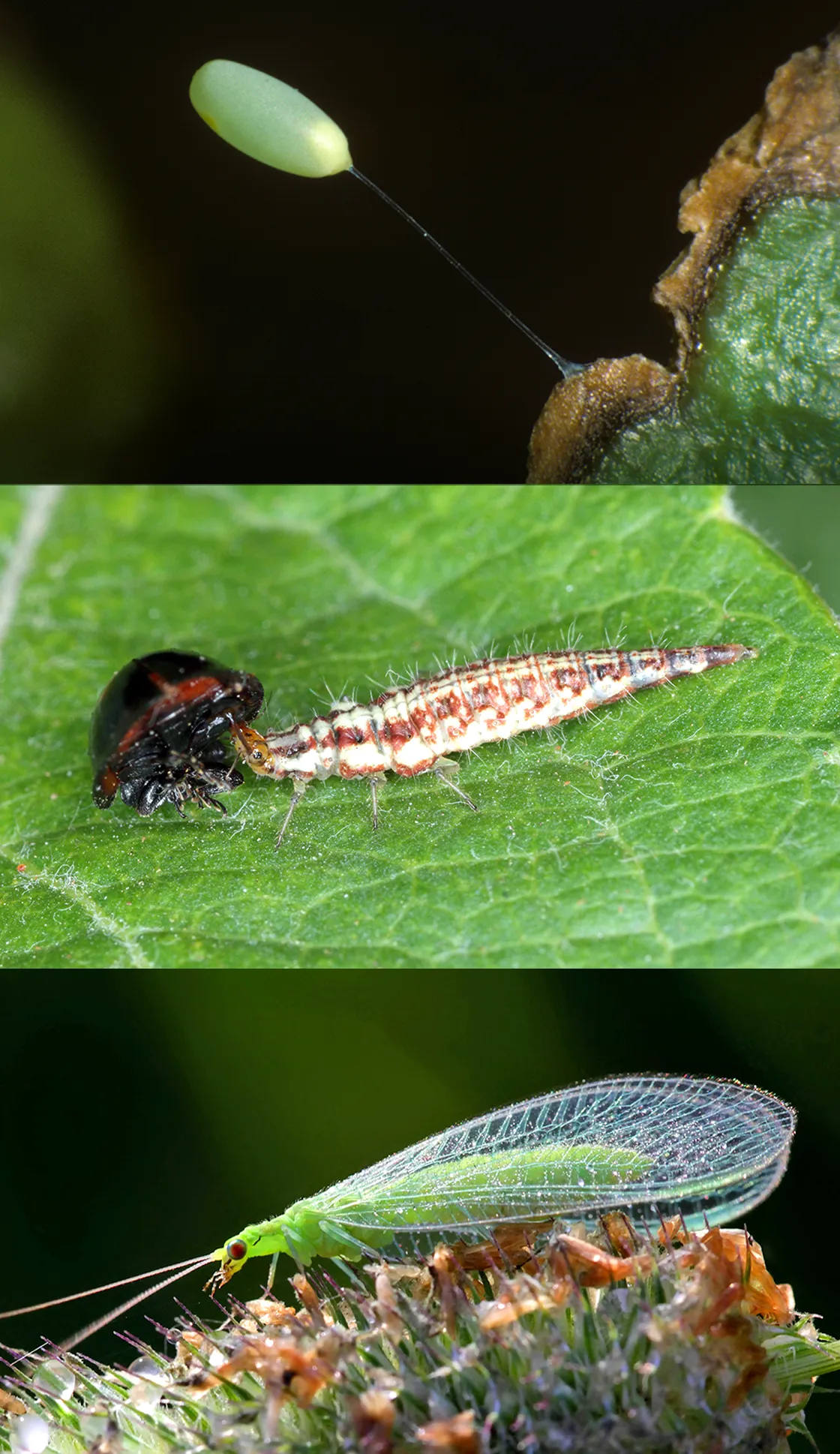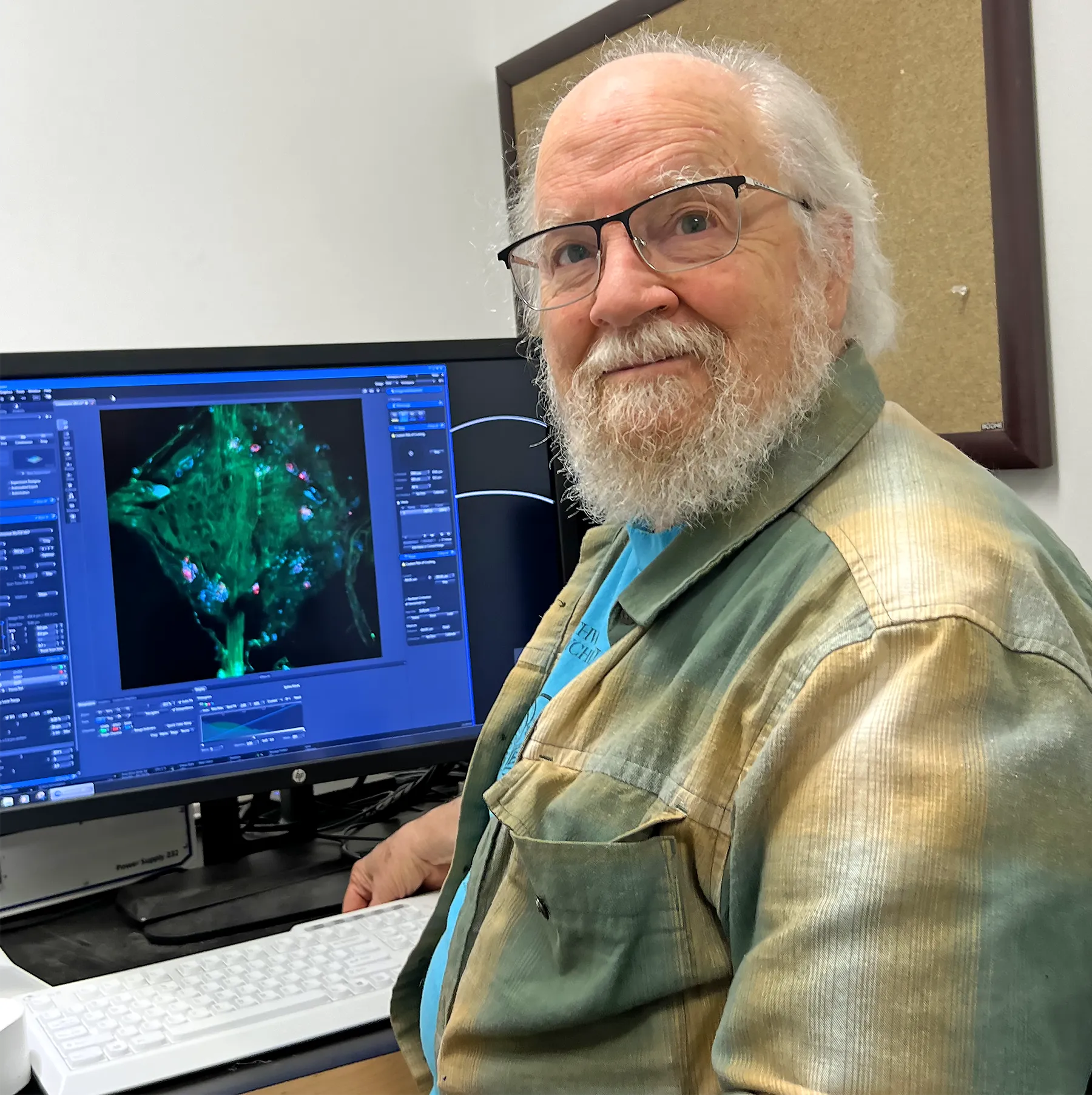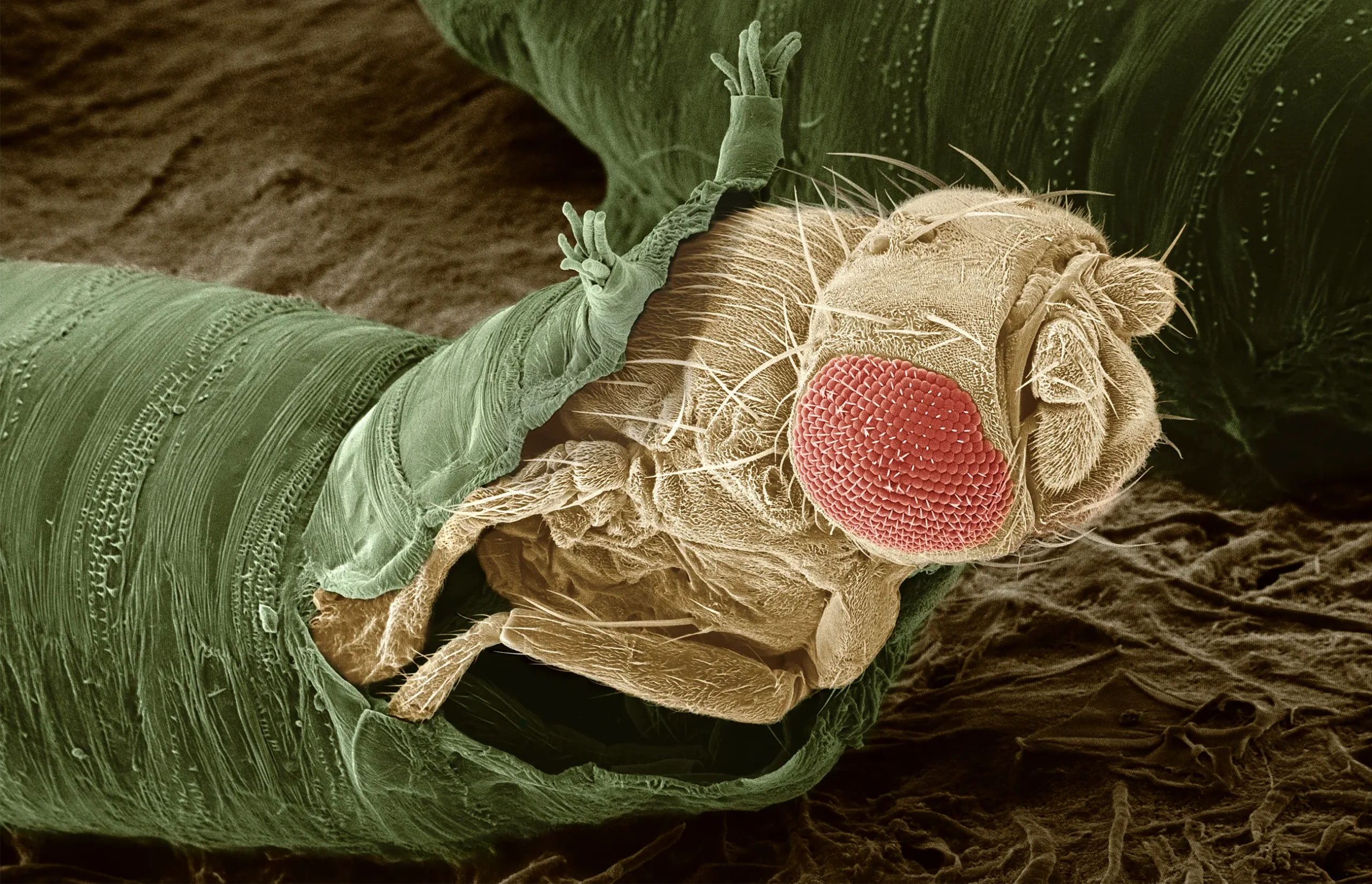Why Insect Memories May Not Survive Metamorphosis
Introduction
On warm summer nights, green lacewings flutter around bright lanterns in backyards and at campsites. The insects, with their veil-like wings, are easily distracted from their natural preoccupation with sipping on flower nectar, avoiding predatory bats and reproducing. Small clutches of the eggs they lay hang from long stalks on the underside of leaves and sway like fairy lights in the wind.
The dangling ensembles of eggs are beautiful but also practical: They keep the hatching larvae from immediately eating their unhatched siblings. With sickle-like jaws that pierce their prey and suck them dry, lacewing larvae are “vicious,” said James Truman, a professor emeritus of development, cell and molecular biology at the University of Washington. “It’s like ‘Beauty and the Beast’ in one animal.”
This Jekyll-and-Hyde dichotomy is made possible by metamorphosis, the phenomenon best known for transforming caterpillars into butterflies. In its most extreme version, complete metamorphosis, the juvenile and adult forms look and act like totally different species. Metamorphosis is not an exception in the animal kingdom; it’s almost a rule. More than 80% of the known animal species today, mainly insects, amphibians and marine invertebrates, undergo some form of metamorphosis or have complex, multistage life cycles.
The process of metamorphosis presents many mysteries, but some of the most deeply puzzling ones center on the nervous system. At the center of this phenomenon is the brain, which must code for not one but multiple different identities. After all, the life of a flying, mate-seeking insect is very different from the life of a hungry caterpillar. For the past half-century, researchers have probed the question of how a network of neurons that encodes one identity — that of a hungry caterpillar or a murderous lacewing larva — shifts to encode an adult identity that encompasses a completely different set of behaviors and needs.
Truman and his team have now learned how much metamorphosis reshuffles parts of the brain. In a recent study published in the journal eLife, they traced dozens of neurons in the brains of fruit flies going through metamorphosis. They found that, unlike the tormented protagonist of Franz Kafka’s short story “The Metamorphosis,” who awakes one day as a monstrous insect, adult insects likely can’t remember much of their larval life. Although many of the larval neurons in the study endured, the part of the insect brain that Truman’s group examined was dramatically rewired. That overhaul of neural connections mirrored a similarly dramatic shift in the behavior of the insects as they changed from crawling, hungry larvae to flying, mate-seeking adults.


The green lacewing is one of the many insects that undergo complete metamorphosis. After hatching from eggs that hang on stalks (left), the vicious larvae (center) prey on other small insects before metamorphosing into graceful winged adults (right).
From left: Nigel Cattlin/Science Source; Tomasz Klejdysz/Alamy Stock Photo; Henri Koskinen/Alamy Stock Photo
Their findings are “the most detailed example to date” of what happens to the brain of an insect undergoing metamorphosis, said Deniz Erezyilmaz, a postdoctoral research scientist at the University of Oxford’s Center for Neural Circuits and Behavior who used to work in Truman’s lab but wasn’t involved in this work. The results may apply to many other species on Earth, she added.
Beyond detailing how a larval brain matures to an adult brain, the new study provides clues to how evolution made the development of these insects take such a wild detour. “It’s a monumental piece,” said Bertram Gerber, a behavioral neuroscientist at the Leibniz Institute for Neurobiology who was not involved in the study but co-authored a related commentary for eLife. “It’s really the climax of 40 years of research in the field.”
“I call this ‘The Paper’ in capitals,” said Darren Williams, a researcher in developmental neurobiology at King’s College London who was not involved in the study but is a longtime collaborator of Truman’s. “It’s going to be fundamentally important … for lots of questions.”
A Detour on the Way to Adulthood
The earliest insects 480 million years ago emerged from eggs looking much like smaller versions of their adult selves, or else they continued their “direct development” to get steadily closer to their adult form, just as grasshoppers, crickets and some other insects do today. Complete metamorphosis seems to have arisen in insects only around 350 million years ago, before the dinosaurs.
Most researchers now believe that metamorphosis evolved to lessen the competition for resources between adults and their offspring: Shunting larvae into a very different form allowed them to eat very different foods than the adults did. “It was a great strategy,” Truman said. Insects that started to undergo complete metamorphosis, like beetles, flies, butterflies, bees, wasps and ants, exploded in number.

The researcher James Truman of the University of Washington has spent his decades-long career trying to understand how and why metamorphosis evolved.
Lynn Riddiford
When Truman was a child, he spent hours watching insects go through the process. With the lacewings in particular, “I was intrigued by the ferocity of the larva versus the delicate nature of the adult,” he said.
His childhood passion eventually turned into a career and a family. After he married his doctoral adviser, Lynn Riddiford, who is also a professor emerita at the University of Washington, they traveled the world, collecting insects that metamorphose and others that don’t, to compare their developmental paths.
While Riddiford focused her work on the effect of hormones on metamorphosis, Truman was most interested in the brain. In 1974, he published the first paper on what happens to the brain during metamorphosis, for which he tracked the number of motor neurons in hornworm larvae and adults. Since then, numerous studies have detailed different neurons and parts of the brains of larvae and adults, but they are either anecdotal or focused on very small aspects of the process. “We didn’t have much of a big picture,” Truman said.
Truman knew that to really understand what’s happening to the brain, he had to be able to trace individual cells and circuits through the process. The nervous system of a fruit fly offered a practical opportunity to do that: Although most of the fruit fly larva’s body cells die as it transforms into an adult, many of the neurons in its brain don’t.
“The nervous system has never been able to change the way it makes neurons,” Truman said. That’s partly because the nervous system in all insects arises from an array of stem cells called neuroblasts that mature into neurons. That process is older than metamorphosis itself and not easily modified after a certain stage of development. So even as nearly all the other cells in the fruit fly’s larval body are eliminated, most of the original neurons are recycled to function anew in the adult.
The Remodeled Mind
Many people imagine that during metamorphosis, as the larval cells begin to die or rearrange themselves, the body of the insect inside its cocoon or exoskeletal casing turns into something like a soup, with all the remaining cells fluidly sliding around together. But that’s not quite right, Truman explained. “Everything has a position … but it’s really delicate, and if you open the animal up, everything just bursts,” he said.
To map the brain changes in that gelatinous mass, Truman and his colleagues scrutinized genetically engineered fruit fly larvae that had specific neurons that shone a fluorescent green under the microscope. They found that this fluorescence often faded during metamorphosis, so they used a genetic technique they had developed in 2015 to turn on a red fluorescence in the same neurons by giving the insects a particular drug.
It’s a “pretty cool method,” said Andreas Thum, a neuroscientist at Leipzig University and co-author of the commentary with Gerber. It allows you to look at not just one, two or three neurons but an entire network of cells.
The researchers zoned in on the mushroom body, a region of the brain critical for learning and memory in fruit fly larvae and adults. The region consists of a bunch of neurons with long axonal tails that lie in parallel lines like the strings of a guitar. These neurons communicate with the rest of the brain through input and output neurons that weave in and out of the strings, creating a network of connections that allow the insect to associate odors with good or bad experiences. These networks are arranged in distinct computational compartments, like the spaces between the frets on the guitar. Each compartment has a task, such as guiding a fly toward or away from something.
Truman and his team found that when the larvae undergo metamorphosis, only seven of their 10 neural compartments are incorporated into the adult mushroom body. Within those seven, some neurons die, and some are remodeled to perform new adult functions. All the connections between the neurons in the mushroom body and their input and output neurons are dissolved. At this transformation stage, “it’s kind of this ultimate Buddhistic situation where you have no inputs, you have no outputs,” Gerber said. “It’s just me, myself and I.”
The input and output neurons in the three larval compartments that don’t get incorporated into the adult mushroom body completely shed their old identities. They leave the mushroom body and integrate into new brain circuits elsewhere in the adult brain. “You wouldn’t know that they were the same neurons, except that we’ve been able to both genetically and anatomically follow them through,” Truman said.
The researchers suggest that these relocating neurons are only temporary guests in the larval mushroom body, taking on necessary larval functions for a while but then returning to their ancestral tasks in the adult brain. That’s in keeping with the idea that the adult brain is the older, ancestral form within the lineage and the simpler larval brain is a derived form that came much later.
Merrill Sherman/Quanta Magazine; source: 10.7554/eLife.80594
In addition to the remodeled larval neurons, many new neurons are born as the larva grows. These neurons are not used by the larva, but at metamorphosis they mature to become input and output neurons for nine new computational compartments that are adult specific.
The mushroom body in the larva looks very similar to the adult version, Thum said, but “the rewiring is really intense.” It’s as if the inputs and outputs of a computational machine all got disrupted but still somehow maintained their wireless functionality, Gerber said. “It’s almost as if you would deliberately unplug and replug” the machine.
As a result, the adult brain’s mushroom body is “fundamentally … a completely new structure,” said K. VijayRaghavan, an emeritus professor and former director of India’s National Center for Biological Sciences who was the main editor of the paper and was not involved in the study. There is no anatomical indication that memories could have survived, he added.
The Fragility of Memory
Researchers have been excited by this question of whether a larva’s memories can carry through to the adult insect, Williams said, but the answer hasn’t been clear-cut.
The types of memories that live in the mushroom body of a fruit fly are associative memories, the kind that links two different things together — the type of memory that left Pavlov’s dogs salivating at the sound of a bell, for example. For the fruit fly, associative memories typically involve smells, and they guide the fly toward or away from something.
However, their conclusion that associative memories can’t survive may not be hold true for all species. Butterfly and beetle larvae, for example, hatch with more complex nervous systems and more neurons than fruit fly larvae have. Because their nervous systems start out more complicated, they may not have to be remolded as much.

Fruit flies undergo one of the most extreme forms of complete metamorphosis. Aside from certain neurons, almost all of their larval cells are replaced with new ones when they become adults.
Dr. Jeremy Burgess/Science Source
Previous studies have found evidence that other types of memories can persist in some species. For example, Gerber explained, observations and experiments suggest that many species of insects show a preference for reproducing on the same types of plants where they matured: Larvae born and raised on apple trees later tend to lay eggs on apple trees as adults. “So one wonders how these two types of observations relate,” he said. How do these preferences carry over if memories don’t? One possibility is that associative memories don’t carry over, but other types of memories housed in other parts of the brain do, he said.
The data offers opportunities to compare the development of nervous systems in animals that metamorphose and those that don’t. The nervous system of insects has been conserved enough during evolution that researchers can pinpoint equivalent neurons in direct-developing species such as crickets and grasshoppers. Comparisons between them can answer questions such as how individual cells changed from having single to multiple identities. It’s “an incredibly powerful comparative tool,” Williams said.
Thum thinks it would be interesting to see whether insect species living in different environments might vary in the ways their brains get rearranged, and whether memories can survive in any of them. Gerber is curious to see whether the cellular mechanisms in insect metamorphosis are the same in other animals that undergo variations of the process, like tadpoles that become frogs or immobile hydra-like creatures that become jellyfish. “You may even be crazy enough to wonder whether we should be looking at puberty as a sort of metamorphosis,” he said.
Truman and his team are now hoping to dive down to the molecular level to see which genes affect the maturation and evolution of the nervous system. In 1971, researchers hypothesized in a theoretical paper that a trio of genes directs the process of insect metamorphosis, an idea that Riddiford and Truman further confirmed in a 2022 paper. But the mechanisms behind how these genes work to remodel the body and the brain remain unclear.
Truman’s ultimate goal is to coax a neuron to take on its adult form in the larval brain. Successfully hacking the process might mean that we truly understand how these insects create multiple identities through time.
It’s unknown what the patterns of reorganization would be like elsewhere in the brain. But it’s likely that some aspects of the fruit fly’s mental capacities and responses to the world, conscious or not, are shaped by its larval life, Truman said. “The challenge is in trying to find out the nature and extent of these effects.”



